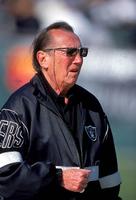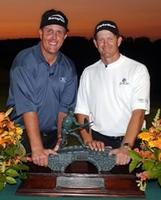This isn't surprising to me as it makes a lot of common sense. However, critics will say that Wie isn't ready for a pro career yet and point to her lack of wins as the primary reason. But did anyone seriously think that Michelle should have won the tournaments that she played this year? It would have been a minor miracle for any 15 year-old to win any of the events that she played. Her results so far have been more than impressive.
 Nonetheless, the standard argument is that there is an "art to winning" and that Michelle just hasn't learned it yet. As Al Davis would say, "Just Win, Baby." While I do believe that this argument holds merit, as it has worked for Tiger and Phil, I do not believe that it is a necessary requirement for success as a pro.
Nonetheless, the standard argument is that there is an "art to winning" and that Michelle just hasn't learned it yet. As Al Davis would say, "Just Win, Baby." While I do believe that this argument holds merit, as it has worked for Tiger and Phil, I do not believe that it is a necessary requirement for success as a pro.Many believe that Michelle should play amateur events to rack up these all-important wins. But there are a number of accomplished amateur golfers who haven't done jack at the pro level. Consider the prestigious U.S. Amateur, the oldest USGA championship that crowned it's 105th champion this weekend. It is considered to be one of the hardest golf tournaments to win. It's tough just to qualify to play in the tournament, let alone win the darn thing. Over the last 20 years, here are some of the names of its past champions: Sam Randolph, Buddy Alexander, Eric Meeks, Chris Patton, Mitch Voges, John Harris, David Gossett, Jeff Quinney, and Ben "Bubba" Dickerson. While these guys earned a degree in the "art of winning," they just weren't able to take it to the next level.
On the women's side, remember Kelli Kuehne? She won two straight U.S. Women's Amateurs and the Women's British Amateur. She turned pro at the end of 1996 and hasn't done much so far.
If it's so important for Michelle to win, I'd be happy to play against her for as many heads-up matches as she wants. Whether it's match play or stroke play, I'd try my very best to beat her. But that's like William Hung trying to out-sing Sinatra. I have no doubt that Wie would win 1,000 straight matches against me without lifting a finger. Unfortunately, it wouldn't do her an ounce of good.
I think that Michelle Wie is such a gifted golfer that she'll learn the "art of winning" on the pro level. I believe that her deep experience on the pro tours has been more beneficial to her than if she would have played on the amateur circuit. She has learned what it takes to be successful on the pro tours, and she understands her weaknesses that she must improve. This knowledge would have likely been unavailable to Wie on the amateur level.
For example, while Michelle has an amazing golf game, a glaring weakness has surfaced in her game: putting. On the amateur level, Wie could have easily dominated the competition even with a shaky flat stick because the rest of her game is so phenomenal. As a result, she likely would have glossed over the importance of putting. However, on the pro level, poor putting is the kiss of death. Michelle is learning this first-hand and early in her development which she can address immediately. Tiger learned this early in his pro career, something that Michelle is learning even earlier. Michelle Wie's golf swing is already considered one of the best, so if she can turn her putting around, the wins will follow. Be patient Mr. Davis.






